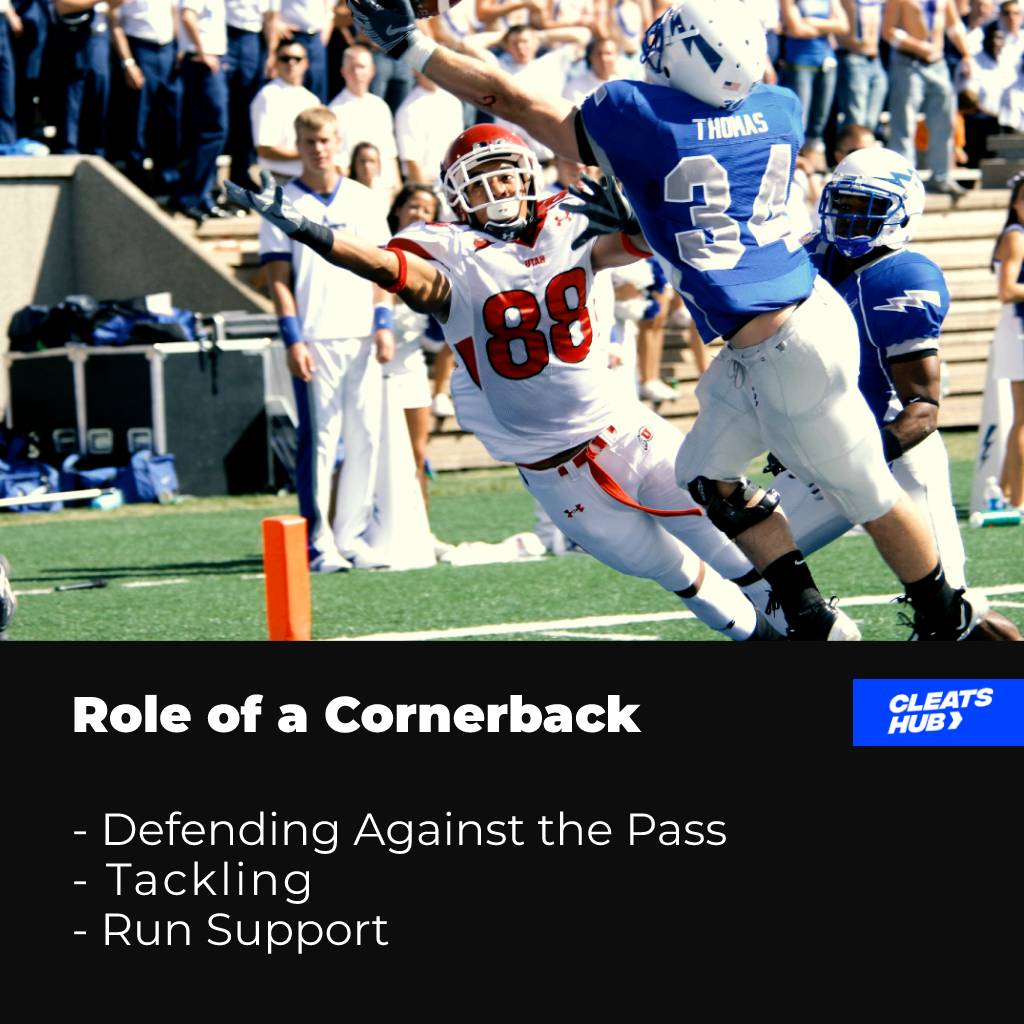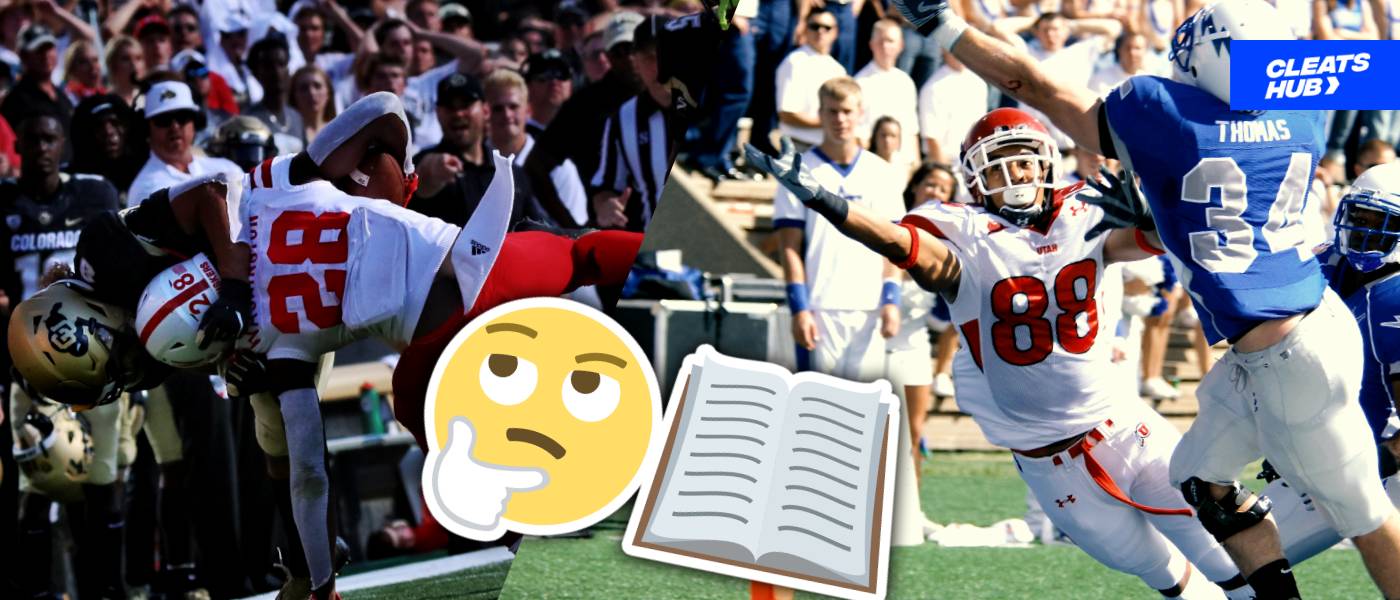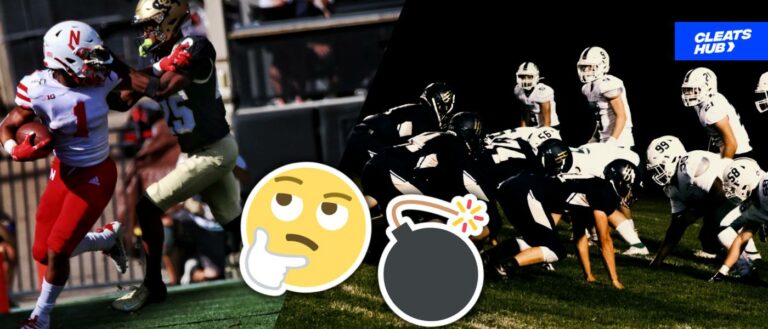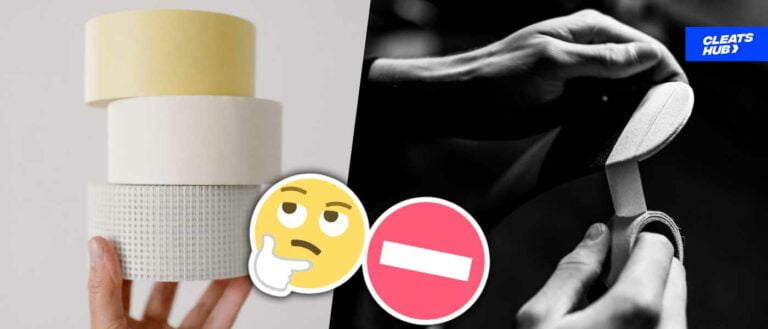What is a Cornerback (CB)? NFL’s Shutdown Specialists
The NFL shutdown specialist refers to the position comprising players who are elite in stopping the pass game, which is led by the quarterback to the wide receivers. The position saddled with this responsibility is none other than cornerback.
Having looked at a number of positions in football, today we will be looking at the cornerback position in football along with their roles, techniques, and skillsets.
About The Cornerback In Football?
The cornerback is one of the three positions that are considered to make up the defensive back: free safety, strong safety, and cornerback. As a position, cornerbacks have the specific role of guarding and marking wide receivers, altering and intercepting all plays that could lead to a touchdown.
Among the measures employed by cornerbacks are intercepting passes sent to the wide receivers by the quarterback. The actions of trailing, reading, and mimicking the actions of the wide receiver are so that the offense is unable to get open to receive a catch and go for a touchdown.
Cornerbacks also go against running backs to prevent them from gaining yardage and cutting through the defense.
Is The Cornerback An Offensive Or Defensive Position?
The cornerback is one of the defensive position players in football, positioned very near the end zone. In most instances, they are the last and final defense between the offense of the opposing team and a touchdown.
Are Cornerbacks And linebackers The Same?
Cornerbacks and linebackers, although both play defense and have closely similar roles, have some differences between them. For one, while linebackers are positioned behind the defensive line, cornerbacks are found deeper in defense and closer to the end zone and sidelines.
In terms of build and physique, linebackers are bigger, larger, and more built. This is due to their role, which involves taking down the offense and fighting through blocks from the tight end.
In contrast, cornerbacks have a smaller build and physique and are generally faster and more agile. Clearly, a factor attributed to the fact that they will have to keep up with wide receivers.
Another difference in their role exists in the offensive position they cover. While a cornerback mainly covers the wide receiver in a one-on-one to intercept passes from the quarterback, the linebacker goes on to tackle the QB, stopping him from making the pass.
What Makes Cornerback A Hard Position?
While not the hardest position in football, the cornerback ranks high on the list of the hardest football positions. This is especially true with NFL rules that favor wide receivers. One of these rules gives a 40-yard pass interference penalty for pushing the wide receiver, making it hard to efficiently mark and trail wide receivers.
Moreover, a cornerback needs a high level of intelligence and physical stamina, as he needs to be able to outperform the wide receivers, who are usually one of the most elite offenses on a football team.
What Does A Cornerback Do? (Roles OF The CB)

In American football, a cornerback’s primary responsibility is to cover the opposing team’s receivers, prevent them from receiving passes, and thwart offensive plays.
Pass Coverage
Defending against the pass is a cornerback’s main duty. They must be adept at press coverage, which entails jamming the opposing receiver at the line of scrimmage to mess with their timing and route.
In addition, to be in the best possible position to make a play on the ball, cornerbacks need to be able to read the other team’s plays.
Also, excellent speed, agility, and quickness are necessary for cornerbacks.
Tackling
Cornerbacks also need to be adept at tackling. When the opposition side runs the ball, cornerbacks need to be nimble enough to get to the line of scrimmage and make a tackle on the player.
Secondly, they must be able to defeat bigger, stronger adversaries without being duped or turned around. Strong tackling methods can stop massive progress made by the opposition’s team.
Run Support
Cornerbacks must be able to assist the run defense in addition to their primary responsibility of pass coverage.
In order to prevent a running back from gaining ground, they could blitz the quarterback and tackle the ball carrier.
Also, cornerbacks that are strong in run support can stop the other team’s offense and create space for their own team’s offense.
Ball Skills
Finally, cornerbacks need to be skilled with the ball. It includes the capacity to recover fumbles, break up and intercept passes.
Good ball-handling abilities can contribute to turnovers and shift the game’s momentum in the defense’s favor.
Types of Cornerbacks

There are several kinds of cornerbacks as well. Some of the most typical varieties of cornerbacks are listed below:
Shutdown Cornerback
Cornerbacks who can shut down the opposing team’s top receiver are frequently recognized as the best in the game. Because they are often incredibly quick, nimble, and have outstanding ball skills. These cornerbacks can easily make interceptions and break up throws.
Cornerbacks such as Deion Sanders and Darrelle Revis are examples of shutdown corners.
Cover Cornerback
Cover cornerbacks are skilled at playing in zone coverage and are commonly used to cover the opposing team’s second or third receiver.
They may not be as quick or nimble as lockdown cornerbacks, but they are excellent at reading plays. Cornerbacks who cover include, for example, Richard Sherman and Aqib Talib.
Slot Cornerback
Slot cornerbacks surround the opposing team’s slot receiver, who is positioned between the outside receiver and the offensive line.
Cornerbacks in the slot must be quick and fluid since they often have to defend smaller, more nimble receivers. Cornerbacks Chris Harris Jr. and Tyrann Mathieu can both line up in the slot.
Nickel Cornerback
Nickel cornerbacks are typically utilized in nickel packages, which are defensive tactics that employ five defensive backs rather than four.
These cornerbacks must be versatile in order to play man coverage, zone coverage, or blitz the passer. Two examples are nickel cornerbacks Jason Verrett and Kenny Moore II.
Physical Cornerback
Physical cornerbacks use their stature and aggression to hamper opposing receivers.
Second, they may obstruct the receiver’s path by employing bump-and-run coverage or jamming techniques. This will make it difficult for them to make effective plays.
Cornerbacks like Josh Norman and Richard Sherman are two of their best players.
Skills Required to Play Cornerback

A variety of talents, both physical and cerebral, are needed to play cornerback. The following are some of the most crucial abilities needed to succeed in this position:
- Speed:
Cornerbacks must be quick and nimble because they are in charge of covering opposing wide receivers and pursuing running backs. - Quick Reflexes:
Cornerbacks must be quick to respond to opposing teams plays, shifting course and making quick modifications to their actions. - Agility:
Cornerbacks must be able to shift directions quickly and move fluidly. Because they must constantly adjust their positioning to keep up with the opposing team’s receivers. - Strength:
Although they may not be the biggest players on the field, cornerbacks must be strong enough to match up with opposing receivers. - Awareness:
Cornerbacks must be able to read the opposing team’s plays and forecast their next moves. - Focus:
Cornerbacks must be able to stay concentrated throughout the game due to continual pressure from the opposing offense. - Communication:
Cornerbacks must be able to communicate well with other players in order to work together to stop the opposing offense.
Strategies and Techniques Used by a Cornerback

Cornerbacks use several strategies to thwart the opposing team’s offense. The following techniques and tactics, which are among the most effective, are frequently used by cornerbacks:
- Press Coverage:
In press coverage, the cornerback positions himself up close to the opposing receiver to obstruct their mobility and prevent them from finding an opening. This method requires a lot of physical strength and rapid reactions. - Zone Coverage:
Instead of focusing on a single receiver, the cornerback employs zone coverage to cover a specific area of the field. The cornerback can read the opposition’s plays and adjust their positioning accordingly. - Man Coverage:
In man coverage, the cornerback covers a single receiver throughout the game to prevent them from making advantageous plays. This technique requires a high level of agility and quick reflexes. - Jamming:
As soon as the ball is snapped, the cornerback makes contact with the opposing team’s receiver in an attempt to disrupt their path and prevent them from finding an opening. Employing this technique necessitates a great deal of physical power as well as quick thought. - Bump-and-Run:
In bump-and-run coverage, the cornerback positions himself near the other team’s receiver and makes contact with them at the line of scrimmage.
Top Cornerbacks in NFL History

It’s difficult to narrow down the top five cornerbacks in NFL history.
However, here are the top five cornerbacks in NFL history, though, after thorough deliberation.
1. Deion Sanders
The best cornerback of all time, Deion Sanders, changed the way the game was played on the field. The top receiver for the other side was tackled by Sanders, who is known for his agility and speed. Sanders was also capable of returning kickoffs and punts for touchdowns.
Sanders won two Super Bowls and was selected to the First Team All-Pro seven times.
2. Rod Woodson
During his playing career, Rod Woodson, a dynamic athlete, alternated between cornerback and safety.
He was also a Super Bowl champion, a Pro Bowler thirteen times, and a member of the NFL’s All-Decade Team for the 1990s. Woodson was well known for his athletic strength as well as his ability to analyze opposing offenses.
3. Mel Blount
Mel Blount dominated at cornerback for the Pittsburgh Steelers in the 1970s. He was awarded First Team All-Pro five times, won four Super Bowls, and was named NFL Defensive Player of the Year in 1975.
Furthermore, Blount was regarded as being big and strong, allowing him to physically outclass other receivers.
4. Champ Bailey
Champ Bailey was a dependable cornerback who played for the Washington Redskins and Denver Broncos during his career.
In addition, he was named to the NFL’s 2000s All-Decade Team, the All-Pro First Team three times, and the Pro Bowl twelve times. Furthermore, Bailey was well-known for his speed, athleticism, and propensity for making decisive plays.
5. Darrell Green
Darrell Green, one of the league’s fastest players, spent his entire tenure with the Washington Redskins.
In addition, he was named to the All-Pro First Team four times, participated in the Pro Bowl seven times, and won two Super Bowls. Moreover, Green was renowned for his quickness and speed, which enabled him to keep up with the league’s fastest receivers.
Best NFL Cornerbacks Of The 2022 Season
| Ranking | Names | W.Avg | PFF Rank | Score Ranking |
| 1 | Sauce Gardner | 3.15 | 1 | 3 |
| 2 | Patrick Surtain II | 11.45 | 2 | 6 |
| 3 | James Bradberry | 12.38 | 7.5 | 26 |
| 4 | Jaire Alexander | 13.88 | 3.5 | 18 |
| 5 | Stephon Gilmore | 14.95 | 8 | 19 |
| 6 | Tyson Campbell | 15.24 | 11 | 11 |
| 7 | Patrick Peterson | 16.35 | 4 | 4 |
Conclusion
In conclusion, a cornerback on a football team is not simply any regular player. They are the defenders of the gridiron, responsible for protecting their team’s end zone.
Speed, agility, and the capacity to read the plays of the opposition are necessary for this role. Not to mention, a cornerback can make even the most self-assured quarterback second-guess throwing in their direction.
Even though they might not always get the attention they deserve, they are an essential component of any successful football team.







